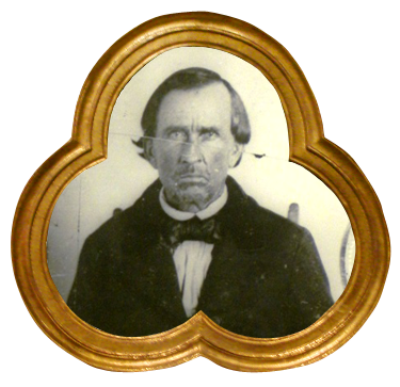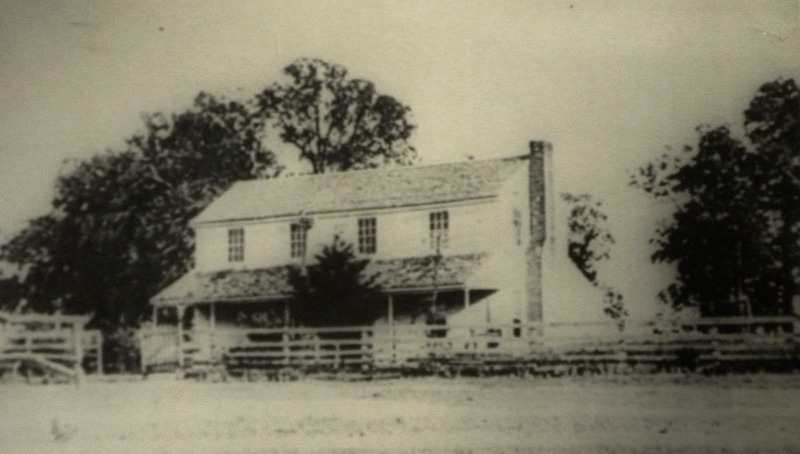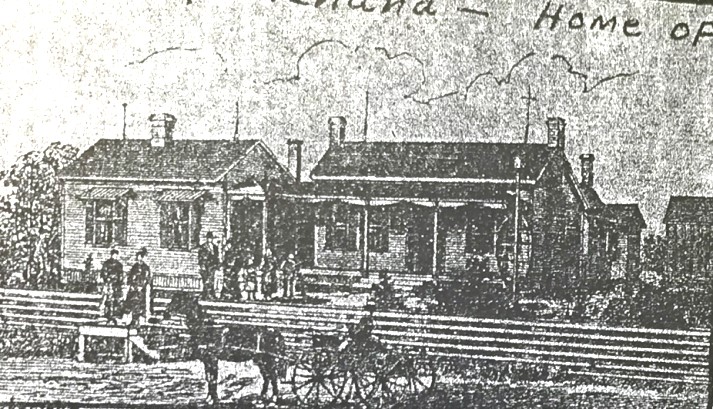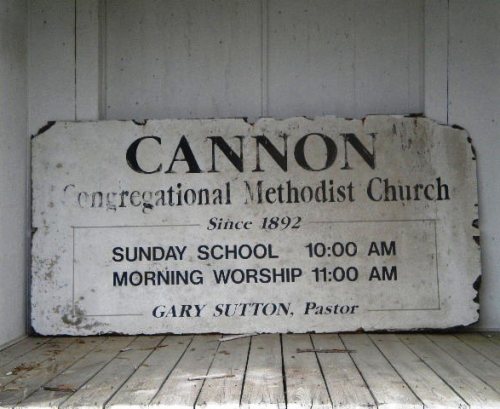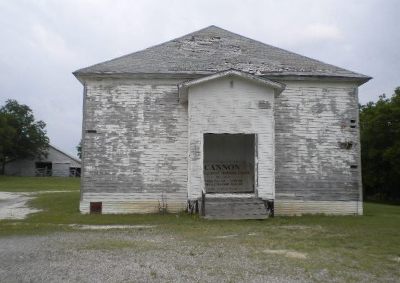
Trails of our Past Along came Cannon
Will of Russell Cannon - July 10, 1824 In the fall of 1852, a widowed Elijah Cannon, aged 56, migrated from Pickens County, South Carolina to southeastern Grayson County with his 11 children, widowed sister and a number of slaves. The group traveled the 1200 miles by wagon and settled about 6 miles east of where the future sight of Van Alstyne was to be established some twenty years later. His sister, Patsy Brown was the acting mother of his children who ranged in age from adulthood to two years of age.
Purchasing 700 acres of land, Mr. Cannon began to establish himself and his family by building a large two story home with ten foot ceilings and fire places on both ends. The house later burned in the early 1900’s, but was situated adjacent to where Clyde Massie resided for many years. The children of Elijah and Dorcas Bowen Cannon were as follows: Elizabeth Cannon Clayton; John R. Cannon; William R. Cannon; Martha Cannon Baker; Reece M. Cannon; Huldah Cannon Hall Shumate; Woddy H. Cannon; Eliza Cannon West; Elijah H. Cannon; Oscar M. Cannon and Sultana Cannon Blassingame. One of the better known of the Cannon children was Reece M.
Cannon who was instrumental in the development of the small community that was
to become Cannon. His first wife, Texana Dumas was the first white child born
in Grayson County, having been born on nearby Sister Grove Farm. Reece had a
farm of fourteen hundred acres in Cannon which was called, "Minnehaha". This
appears to have been located on the north side of highway 121 just before
entering into Cannon.
At the end of the Civil War, Elijah freed all of his slaves, giving them 20 acres and the last name of Boyd. Upon returning from war, Reece was quick to notice that cotton was the crop of choice and immediately set about to becoming as successful as possible in this regard. He helped establish the first cotton gin in the area in 1868, operating for almost 75 years when he sold it to the Van Alstyne Cotton Oil Company. There was also established by the Cannon family a grist mill and a wagon factory to help transport the goods. By all accounts, Cannon was a booming community becoming self-sufficient by the 1870’s.
By 1880 there were two churches in the small community, hosting to circuit preacher riders. The Cannon Congregational Methodist church was founded in 1896 and a building was constructed the following year. This building still stands off of road 2729, however due to lack of care and maintenance, its future does not look bright. According to the old Methodist sign, it was founded in 1892. One notable pastime of this church is that every Saturday there would be a potluck meal for the community and they would be entertained by singing from local residents. Some references state that the Methodist church was founded much earlier than this by the Cannon family and that services were held in their homes. In the 1970’s, Arnold Wiggins was the only pupil to attend the church. He went every Sunday for an hour of prayer. This was publicized and the old members started returning to church in 1975. Some old time members of the church were: Rev. Pinkney Shaw, C. H. Hill, Frank Mann and Rev. Beecher Airhart. On October 6, 1985 a new Cannon Church started out as a mission church, holding its first meetings on Wednesday nights in a mobile home next to the Cannon Cemetery. It was sponsored by the First Baptist Church of Van Alstyne, with Scott Jordan being the pastor of that church. Soon, it developed into the establishment of Cannon Baptist Church, holding a ground breaking for the new building on August 17, 1986 and cement pouring on August 30. The first services were held on December 28, 1986. Mike Weatherly and Gary Philbrick were the first deacons ordained, with Mike Nevil serving as deacon chairman for many years. Rev. John Wade was the pastor and was also instrumental in developing the new church. He continued to pastor the church until his retirement in 2008. In 1877 a post office was established when population numbers reached as high as 400, the post office was named Cannon in honor of Reece M. Cannon and the post master was H. D. Hoard. In 1889, James Binion was the postmaster at Cannon post office. The post office ran until 1907 when population numbers fell below 50. Other nearby post offices and settlements were, Lick Skillet, later renamed Pilot Grove, to the east and Yakima, later renamed Sedalia, to the south. Histories of these two communities can be found in future editions of, The Trails of our Past. The private school, The Centennial Institute, was established in the winter of 1876-1877 and ran for twelve years and was a college in many ways. It had a dormitory and somewhere around 30 rooms. In later years, the Mason and Eastern Star fraternities used the building and renamed it Centennial Masonic Lodge No. 500. The building burned around 1888 and was not rebuilt. According to Hattie A. Cobb’s obituary, she was once a teacher at the Centennial Institute. The Van Alstyne Leader stated the following on March 23, 1939: “Back yonder in the early 80’s, the deceased was a teacher in Centennial Institute, now the Cannon school. John A. Cobb was the president; his brother, Joseph L. Cobb was assistant; Miss Julia and Miss Hattie Benson were assistants in English, History and Music. At that time, this school was the biggest, best, and most popular school in North Texas, save and except, that taught by Capt. J. H. LeTellier of Sherman. The large boarding house standing by was filled with pupil boarders from Sherman, McKinney, Greenville, Fort Worth, Dallas, and all the other smaller towns in several adjoining counties. The deceased’s pupils at that time were the younger Cannons, Caraways, Binions, Thompsons, Milams, and so on, a long list of them; and many of the grade children of her pupils are scattered still throughout this community. The two brothers, John A. Cobb and Joseph L. Cobb, married the two sisters, Julia and Hattie Benson.” According to G.B. Ray in her book, Murder at the Corners, Dorinda Pearce attended a seminary at Cannon in the 1860s, thus insinuating that an institution was established at an earlier date. According to Catherine Cannon's History of the Cannon Family, the Centennial School was founded in 1866. A public school was started after the demise of the institute and ran until just before World War II when it consolidated with Van Alstyne, Cannon being a two teacher school at the time. In 1924, the teachers at Cannon were Mrs. D. W. Jay (Willie McMillan), Ruth McMillan (cousins to my grandmother, Ollie Edmonds, of Van Alstyne) and Marie Lucas. In the early 1920’s, with an increase in bond money, a new school building was erected. The school was located just north of highway 121 on the west side of 2729. According to an 1887 letter written by Laura Jernigan, Cannon received a newspaper called The Educational Journal, the editor being R. W. Dick, president of the school at the time. She also mentioned that the school was a fine one and that there was a fine literary and music program. There was also literary and debating societies held every Saturday night. The Jernigan land was located south of Cannon near Sedalia off of Wolf Front Road. Jernigan cemetery is nearby.
At the corner of highway 121 and 2729 was the general store. The store functioned after everything else was closed down and in the end the building was moved elsewhere. Some of the people who ran the store were: G. A. Jackson, Jasper Hammons, Jim McDougal, the Dutton Family, C. P. Neatherly, Junior Hunter and Mr. and Mrs. A. A. Timmons. It is unknown when exactly the store was founded, however all evidence appears to indicate that it was started by the Cannon family. The Cannon store was the place to be on Sunday afternoons as everyone gathered to share news and gossip about the community. Many couples met here and were married in years to come. Basketball and baseball games were also prominent among the residents. A practice field called Pebble Ridge was located nearby off of Wolf Front rd. There was also a filling station in the area. In 1965, the annual Cannon community reunion was held at the Allen-White Lake, across the road north of the Cannon Cemetery. The Cannon cemetery was donated as a burial grounds by
Elijah Cannon, however it was deeded for burial use in 1874 by O. M. Cannon.
The first known burial was that of Nancy Bowen who passed away on July 21,
1857. Adjacent to this cemetery is a burial ground that was established for
former slaves, the oldest known graves here being that of Billy and Glory Boyd
in 1880. Aunt Patsy Brown passed away on March 6, 1885 and was laid to rest in
the Cannon Cemetery. She was mourned so greatly by her nieces and nephews that
they had a special elegant coffin designed for her and although it was not the
custom, they held a wake in her honor. Elijah lived until October 21, 1887 and
was also laid to rest here where so many of his family and friends are also at
peace.

Trails of Our Past Biography Index Cannon History Copyright © 2025, TXGenWeb. If you find any of Grayson County TXGenWeb links inoperable,please send me a message.
|
